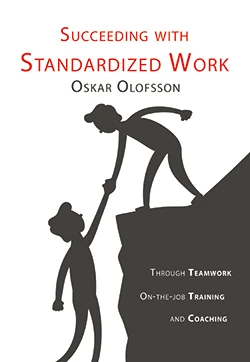
In Lean Production, we usually say that information technology solutions are not so important for process improvements. Instead, we normally advocate manual systems such as pen and paper. One argument is that staff become more committed in the initiative when they have measured and written the result by hand compared to when the results are automatically provided by a computerized system.
While this is true to a certain extent, it is only half the story. Computerized systems as in the Industry 4.0 framwork are very relevant in lean projects, but one needs to use the support provided at the right time and for the right purpose.
Manual systems are best when you have ventured into unknown territory. When you are trying to learn processes with which you are not very well acquainted it is best to measure manually and take notes with pen and paper. In this way everyone learns together, things are easy to explain, and many people can be active in the improvement process.
Information technology systems can be used later to maintain the achieved level, once we have understood and improved the process.
An example
A company has a problem with the quality performance on one of its products. Far too often, the products need to be re-worked to render them saleable.
The company works according to lean principles and appoints a cross-functional task force to tackle the problem. The group outlines the problem by measuring and analysis to better understand the situation. They visualize the result on a board and eventually conclude that the problem is due to four factors.
After their correction, they succeed in reducing the re-work requirement by 90% and the project is a resounding success.
This is all very well. Do information systems feature in the picture? The answer is that we use information technology to standardize the new operating procedure, after having solved the problem. The project has taught us that we need to keep an eye on four important process parameters. To do this manually is fine in the short term, but if the operators are expected to follow these parameters manually in the longer run, we require someone to check the figures and react to any deviations. If we do not have the resource for this, it is far better to automate the process. In this way, we have used the experience gained from our lean project to create systems that maintain the new standard.
During the lean process, the demand for different types of computerized systems is going to arise. There are three different ways of dealing with this. Without a strategy, we will probably use methods one or two, but often method three is that which would be most advantageous for the company.
With well-thought-out decisions, you will end up with platforms that can be expanded and you avoid a motley assortment of systems – one for each need that you have identified over time.
Lean can often function well without the need to build up any new system support. In the initial stages of a lean project, this is almost always the case. We can make good progress with manual systems if we use methods like 5S and setup reduction for example. If the production process is relatively simple, we could consider that we'll never need information technology.
However, with complex production processes or where a high level of, for example, reliability, traceability and/or documentation is demanded, we usually realize, sooner or later, that we need to develop information technology support to progress in our lean project.
Examples:
Function: OEE Measurement
The establishment of a comprehensive factory OEE system allows information from the entire factory to be collected at one central point. In this way we can, for example, compare the performance of the different production lines. We can speed up decision-making in the event of breakdowns and get good information to help with our improvement process.
Function: Electronic batch documentation
You will notice that companies with high levels of documentation experience difficulty in reducing batch sizes. Batch costs in such companies are not primarily associated with the conversion process, but it is instead the documentation and the reviewing process that hampers reduced batch sizes. Once you have reduced changeover times with SMED as much as you can, you will need to automate batch documentation to progress further.
Function: Detailed Planning
Detailed planning and the staffing of production are often time-consuming tasks, invariably carried out by a senior production person, using a personal Excel sheet. Using the visual Kanban system, this can be simplified. However, if production flows are complex, or you need traceability, you will need computerized systems. Getting real-time information from production simplifies detail planning, and we can use production resources more efficiently.
Function: Historical database and trend tools
Six Sigma projects and other activities based on statistical analysis are often successful techniques since they give a deeper understanding of the production processes being investigated. The trouble is that the collection of data is often time-consuming, which is why this type of analysis is seldom undertaken. Creating control charts and data to make decisions based on facts requires access to data, a good historical database and tools for analysis.
With lean methods such as TPM, reliability can be improved and costs reduced at the same time by involving production personnel in the maintenance function. To achieve this does not require any additional system support outside of the normal maintenance procedures which are standard in most companies nowadays. To progress further and optimize maintenance, however, you will reach a point, sooner or later, where data is required to make decisions based on facts. For critical equipment that demands a high level of reliability, and stable processes, real time monitoring is necessary. In that way, an abnormal operation is detected early, and breakdowns can be avoided.
Lean and computerized systems are not the opposite of one another. Instead, they complement one another and should be used together in a strategy that produces ever-improving production. To ensure progress in lean projects and establish the new style of working as a standard often requires computerized systems.
By Oskar Olofsson

Making lean work for you

World-Class / Lean Manufacturing

5S Implementation

SMED Quick Change-over

TPM and Plant Maintenance

Succeeding With Standardized Work

Succeeding With 5S